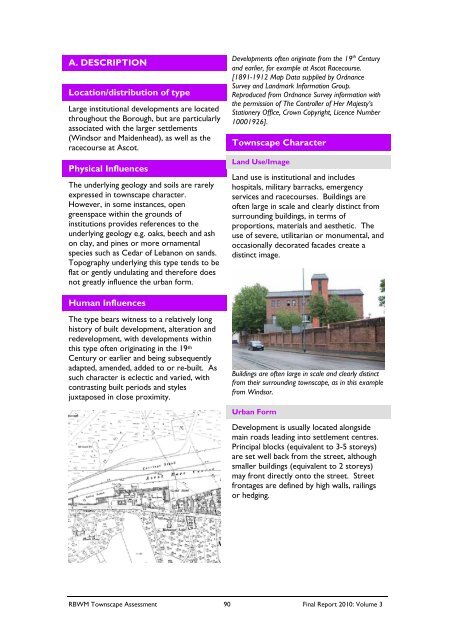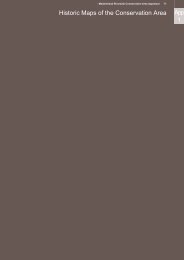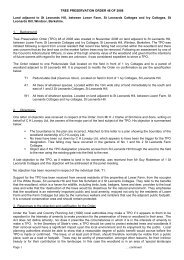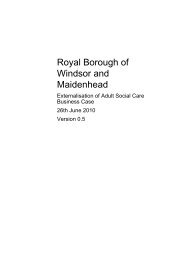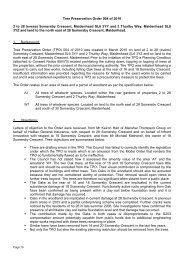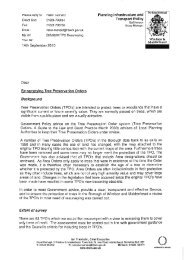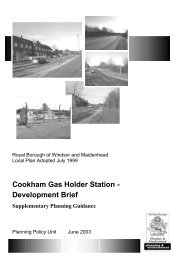5: victorian villages - The Royal Borough of Windsor and Maidenhead
5: victorian villages - The Royal Borough of Windsor and Maidenhead
5: victorian villages - The Royal Borough of Windsor and Maidenhead
Create successful ePaper yourself
Turn your PDF publications into a flip-book with our unique Google optimized e-Paper software.
A. DESCRIPTION<br />
Location/distribution <strong>of</strong> type<br />
Large institutional developments are located<br />
throughout the <strong>Borough</strong>, but are particularly<br />
associated with the larger settlements<br />
(<strong>Windsor</strong> <strong>and</strong> <strong>Maidenhead</strong>), as well as the<br />
racecourse at Ascot.<br />
Physical Influences<br />
<strong>The</strong> underlying geology <strong>and</strong> soils are rarely<br />
expressed in townscape character.<br />
However, in some instances, open<br />
greenspace within the grounds <strong>of</strong><br />
institutions provides references to the<br />
underlying geology e.g. oaks, beech <strong>and</strong> ash<br />
on clay, <strong>and</strong> pines or more ornamental<br />
species such as Cedar <strong>of</strong> Lebanon on s<strong>and</strong>s.<br />
Topography underlying this type tends to be<br />
flat or gently undulating <strong>and</strong> therefore does<br />
not greatly influence the urban form.<br />
Developments <strong>of</strong>ten originate from the 19 th Century<br />
<strong>and</strong> earlier, for example at Ascot Racecourse.<br />
[1891-1912 Map Data supplied by Ordnance<br />
Survey <strong>and</strong> L<strong>and</strong>mark Information Group.<br />
Reproduced from Ordnance Survey information with<br />
the permission <strong>of</strong> <strong>The</strong> Controller <strong>of</strong> Her Majesty’s<br />
Stationery Office, Crown Copyright, Licence Number<br />
10001926].<br />
Townscape Character<br />
L<strong>and</strong> Use/Image<br />
L<strong>and</strong> use is institutional <strong>and</strong> includes<br />
hospitals, military barracks, emergency<br />
services <strong>and</strong> racecourses. Buildings are<br />
<strong>of</strong>ten large in scale <strong>and</strong> clearly distinct from<br />
surrounding buildings, in terms <strong>of</strong><br />
proportions, materials <strong>and</strong> aesthetic. <strong>The</strong><br />
use <strong>of</strong> severe, utilitarian or monumental, <strong>and</strong><br />
occasionally decorated facades create a<br />
distinct image.<br />
Human Influences<br />
<strong>The</strong> type bears witness to a relatively long<br />
history <strong>of</strong> built development, alteration <strong>and</strong><br />
redevelopment, with developments within<br />
this type <strong>of</strong>ten originating in the 19 th<br />
Century or earlier <strong>and</strong> being subsequently<br />
adapted, amended, added to or re-built. As<br />
such character is eclectic <strong>and</strong> varied, with<br />
contrasting built periods <strong>and</strong> styles<br />
juxtaposed in close proximity.<br />
Buildings are <strong>of</strong>ten large in scale <strong>and</strong> clearly distinct<br />
from their surrounding townscape, as in this example<br />
from <strong>Windsor</strong>.<br />
Urban Form<br />
Development is usually located alongside<br />
main roads leading into settlement centres.<br />
Principal blocks (equivalent to 3-5 storeys)<br />
are set well back from the street, although<br />
smaller buildings (equivalent to 2 storeys)<br />
may front directly onto the street. Street<br />
frontages are defined by high walls, railings<br />
or hedging.<br />
RBWM Townscape Assessment 90 Final Report 2010: Volume 3


